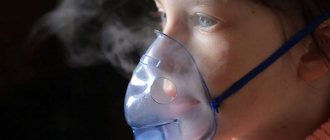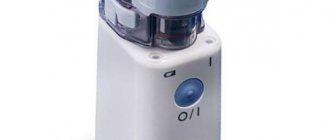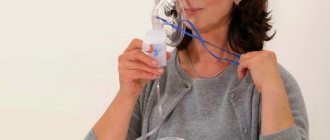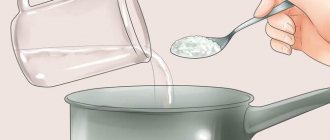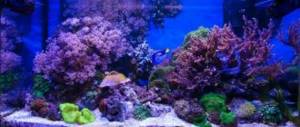Sea salt is used for inhalation with a nebulizer in the treatment of colds and allergies. Procedures are needed to moisturize and cleanse the respiratory tract, relieve swelling and inflammation. Sessions can also be carried out in the form of steam (heat-moist) or inhaling crushed dry salt.
To refill the nebulizer, it is better to use sea water in the form of medications (Marimer, Sialor Aqua). A single dose of the finished solution is 3-4 ml for adults undiluted and 2 ml with 2 ml of saline for children. Thermal procedures are carried out with 500 ml of hot water at 50 degrees and a tablespoon of sea salt.
Inhalations are usually well tolerated, they are allowed for children and pregnant women, but in case of purulent process and fever they are contraindicated without antibiotic therapy.
The benefits of sea salt for inhalation with a nebulizer
Sea water is a natural remedy; when administered through a nebulizer, it helps:
- clear the airways of phlegm, excess mucus, dust and allergens;
- moisten the nasopharynx and larynx;
- relieve irritation, sore throat;
- improve breathing;
- reduce inflammation activity;
- eliminate itching, dry cough and swelling due to allergies;
- restore the structure and function of the mucous membranes.
In addition to the local effect, trace elements of the natural saline solution penetrate into the bloodstream in minimal quantities. This systemic influence is manifested in:
- decreased excitability of the nervous system (bromine, magnesium);
- strengthening bone tissue, teeth (calcium, fluoride);
- normalization of the secretion of hydrochloric acid in the stomach (chlorine);
- improving the condition of muscle tissue (magnesium, calcium);
- maintaining vascular tone (sodium, calcium, potassium, magnesium);
- prevention of tissue destruction, antioxidant effect (selenium);
- increasing the activity of the immune system (zinc);
- stimulating the formation of red blood cells (cobalt, copper).
We recommend reading the article about saline solution for inhalation. From it you will learn about the features of using sodium chloride for a nebulizer, where to store and how long open saline solution is stored, as well as how to replace saline solution for inhalation.
And here is more about the features of inhalations with soda.
Indications for use of saline solution for nebulizer
It is recommended to use saline nebulizer solution for the following diseases:
- colds (especially effective for preventive purposes during the season of viral infections);
- runny nose, inflammation in the paranasal sinuses (sinusitis, sinusitis, sinusitis), adenoids (adenoiditis);
- inflammatory process in the pharynx (pharyngitis), tonsils (tonsillitis, tonsillitis), larynx (laryngitis), trachea (tracheitis);
- damage to the bronchi and lungs (bronchitis, pneumonia, bronchopneumonia);
- bronchial asthma;
- allergic diseases of the respiratory tract.
Contraindications to saline inhalations with a nebulizer
Salt inhalations through a nebulizer are prohibited if:
- body temperature from 37.5 degrees;
- purulent discharge from the nose or an admixture of pus in the sputum;
- bleeding from the nose, bronchi, and lungs;
- high blood pressure;
- severe diseases of the heart and blood vessels (especially coronary and cerebral).
Sinusitis
Inhaling seawater is relatively safe, but it is not effective against bacterial or viral infections. If you use inhalations in the presence of a purulent process and do not use antimicrobial drugs, this leads to the spread of inflammation, a protracted course of the disease, and transition to a chronic form.
Contraindications and side effects
Sea salt has a cumulative effect, retaining moisture. Therefore, the number of procedures should not exceed 4 times a day. Increasing the amount of salt in the diet can lead to harm to health. It consists of 95 percent sodium chloride, therefore the side effects are specific:
- blood pressure may increase
- accelerates the transition of the acute stage of heart failure to chronic,
- leads to diseases of the gastrointestinal tract,
- a cumulative effect is triggered, forming swelling of the face or other parts of the body.
For what diseases are such inhalations contraindicated:
- persistent high blood pressure in the cardiovascular system,
- constant formation of edema,
- diseases of the genitourinary system, especially the kidneys,
- the formation of ulcerative potholes in the intestines or stomach,
- increased tension in the eye muscles, resulting in glaucoma,
- regressive development of heart rhythm,
- chronic fatigue and decreased vitality in the muscles.
How to make an inhalation solution with sea salt
To prepare a saline solution for inhalation with sea salt, which is used to fill the nebulizer, you must:
- Boil 500 ml of filtered water.
- Add 1 level teaspoon of sea salt.
- Set aside for 2-3 hours and stir occasionally until completely dissolved.
- For 1 procedure, take 3 ml of saline solution and 3 ml of physiological solution.
- Pour the mixture into the nebulizer container.
- Turn on spraying.
It is very important to consider that a homemade sea salt solution is well suited for washing and gargling the nose and throat, and caution must be exercised when using unsterile and unfiltered liquid in a nebulizer. Before starting treatment, you should switch the spray mode to the largest possible droplets, their size should be greater than 5 microns .
Not all devices have this function. If, according to the technical characteristics, the aerosol particles are about 3 microns, then it is recommended to use exclusively factory solutions (for example, Physiomer, Aqua Maris and others).
The introduction of small particles contained in a homemade sea salt solution into the lower respiratory tract clogs the smallest bronchial branches and alveoli, which can worsen breathing.
Recipes
Inhalations are performed using the dry method and using saline solution. If there is a temperature of more than 37.4 C, it is more correct to give preference to the first type of procedure. In the second case, the patient’s condition can be aggravated.
Solutions
Medicine for inhalation therapy can be easily prepared at home. Table salt will also work, but use sea salt if possible. Your doctor may recommend any of the following prescriptions:
- Classic inhalation. Prepare this way: dissolve 3 tbsp in 1 liter of water. l. salt, and simmer over low heat for 7 minutes, then cool slightly.
- Add 1 tbsp to a liter of boiling water. l. salt, 1 tbsp. l. baking soda, stir until completely dissolved and let cool slightly. This solution helps to cope with attacks of dry cough, facilitates coughing, and has an antibacterial effect.
- Essential oils improve tissue nutrition, thin mucus, stimulate the activity of ciliated epithelium, and restore mucous membranes. Pour the hot saline solution into the pan, cover with a towel, add 2 drops pre-measured. oils (child 1–0.5 drops). For children under 6 years old, lavender and chamomile are allowed. Older children can take tea tree, eucalyptus, fir, pine, sage, rosemary, lemon, incense. Please note that if you do not have a steam inhaler, you must keep your eyes closed during the procedure. Duration of the procedure is up to 5 minutes.
- For nebulizer. The device cannot be refilled with self-prepared salty medicines. Large particles contained in them can cause damage to the device. The drug purchased at the pharmacy must be diluted 1:1 with saline so that the concentration of sodium chloride is no more than 2%.
In order not to injure or burn the mucous membrane, it is necessary to regulate the temperature of the steam (up to 50 C) during the procedure, changing the distance to the container with water.
If there is a sore throat, you need to inhale the steam through your mouth and exhale through your nose. If you have a runny nose or sinusitis, do the opposite - inhale through your nose, exhale through your mouth.
How to breathe salt correctly and what to do if you don’t have a device
At home, you can breathe salt without a nebulizer; several methods are used for this: steam procedures, through a heat-moisture device, dry procedures with a salt inhaler.
Steam
To inhale steam, prepare a solution of 1 tablespoon of sea salt and 1 liter of boiling water. It is necessary to thoroughly stir the liquid until completely dissolved and cool to 50 degrees. Then the saline solution is poured into a bowl, saucepan or kettle. In the first two options, cover the head with a towel and inhale the vapor for 7-10 minutes, and for children five is enough. The procedures are carried out 2-3 times a day, the course of treatment usually takes about 1 week.
An alternative option is to use a thermos. Hot liquid is poured into it, and a funnel is placed on top to pour the liquid. This method is suitable for the treatment of sore throat, pharyngitis, laryngitis or tracheitis. The peculiarity of steam procedures is that they cannot be used at elevated body temperatures.
Heat sessions are carried out with great care for children; an adult must monitor safety to prevent burns from the hot solution.
Heat-moist
Warm-moist ones differ from steam ones in that the saline solution is poured into a container on which a nozzle is installed. Using such a device is much more convenient, since you can breathe through your nose and mouth at the same time, and salt and steam do not get on the mucous membranes of your eyes. All other rules are exactly the same as for improvised containers. A new solution is prepared for each inhalation.
Dry salt inhalations
There are ways to inhale dry salt. The best results are obtained from sessions in a salt cave (speleotherapy). In such specially equipped rooms, a generator grinds the salt to the smallest particles, and the patient breathes a kind of salt haze.
You can use the Saltpipe saline inhaler at home. It is a housing containing natural salt crystals and filters.
How to use Saltpipe salt inhaler
A handy method for salt inhalation is a Teflon-coated frying pan; cast iron is best. Salt is poured into a thin layer and heated over low heat for 10 minutes. Then the contents are poured into a pan or bowl and covered with a towel; you need to breathe in the fumes for about 5 minutes.
The second option is a coffee grinder on which a funnel is installed (you can cut a regular plastic bottle). First, the sea salt is crushed, then you need to remove the lid and replace it with the nozzle. Breathe small particles for 3 minutes.
Methods of inhalation
The history of inhalation dates back to the beginning of the new era. It was then that a person began to select components, the evaporation of which would bring health to the respiratory tract. The Romans were the first to discover sea salt as an effective means of inhaling it through the nose and mouth and ridding it of redness and germs.
Now there are 4 types of salt therapy. And here they are:
- using steam. This method involves treating the mucous membrane by changing the state of aggregation of water due to its heating. But you need to be careful, this is where the highest probability of getting burned by boiling water arises,
- cool moisture (not higher than room temperature). If you are afraid of hot processing, you can buy sprays with an aerosol nozzle and containing evaporated sodium chloride. A huge advantage is diluting them with medicinal substances or hormones,
- warm-moist. This is an hourglass-shaped inhaler with a special body and a funnel from which salt vapor comes,
- nebulizer The most modern model for inhalation using finely dispersed moisture particles, penetrating even into the lower parts of the lungs.
Can there be adverse reactions from salt inhalations at home?
Salt inhalations can be done at home; they have minimal side effects. Not often, when they are performed, a feeling of irritation and tingling may occur.
Intolerance occurs extremely rarely; it manifests itself in:
- soreness,
- burning in the mouth,
- increased cough,
- nasal congestion,
- difficulty breathing.
If they occur, treatment with saline solution is stopped. It must be taken into account that salt stimulates the discharge of sputum, so the evening procedure should not be carried out immediately before bedtime; the interval should be at least 2 hours.
How to treat a saline inhaler
The saline inhaler is treated only externally. To do this, you can use a damp cloth and then wipe it with a cotton pad soaked in an antiseptic solution (for example, Chlorhexidine or hydrogen peroxide). It is important to prevent moisture from getting inside the device.
When using a nebulizer and saline solution, simply wash all removable parts with warm, soapy water. Once every 2-3 days you need to wipe the mask with an antiseptic. A prerequisite before the next session is to dry the parts.
Features of the procedure
General rules for salt inhalation include:
- take food an hour before, drink a glass of warm drinking water half an hour before, measure your temperature, blood pressure and pulse;
- during the session, do not try to breathe deeply or frequently; after inhaling, hold your breath for a couple of seconds;
- do not be distracted while inhaling the saline solution;
- After the procedure, it is prohibited to eat, drink, smoke, move actively, or go out into the cold for 60-90 minutes.
Watch the video about how to use a salt inhaler:
Salt procedures can be carried out independently for no more than 3 days; if during this period there is no significant improvement in the condition, then this means the need to consult a doctor.
For children
Children are allowed to inhale salt from infancy, but up to 2 years of age, any treatment is prescribed by a pediatrician. During procedures, adults must fully monitor the child’s condition, tolerance, mask fit, and the safety of the location of the device or available means.
For pregnant
During pregnancy, inhalations with sea salt are permitted. They are also useful as a source of iodine, the need for which increases during pregnancy. Inhaling a saline solution is most effective as a preventive measure during the cold season or at the very first symptoms of acute respiratory infections.
Before starting, a doctor’s examination is required, since untimely and improper treatment of bacterial and viral infections is dangerous for fetal development..
Features of treatment with salt inhalations
Inhalations for pregnant women
If a woman is in an interesting situation, then taking usual medications may be limited due to the risk of miscarriage. Most herbs will also have to be abandoned.
Solutions with which components will not harm pregnant women:
- sea salt. Can be used both with and without the device,
- boiled potatoes. For powerful inhalation you will need only two things, which need to be softened when ready. Inhalation is used only in the pan. Does not cause an allergic reaction and protects against the proliferation of microbes. It even treats a long-term runny nose and removes phlegm from the lungs.
Steam therapy is limited to 10 minutes. In case of a difficult pregnancy, it is better to abstain.
Inhalations for children
If your child cannot overcome a series of illnesses, then he needs steam inhalation. Moreover, it is best to use the inhaler in a playful environment at home, thereby involving the baby in the process of learning and healing.
What is good for children and what is bad according to age:
- for a baby, it is necessary to make solutions on a gentle basis: sodium chloride, mineralized water or a decoction of field chamomile. Other products, including salt, can have a detrimental effect on the baby,
- if the child is not yet three years old, then the options expand to baking soda, onion and garlic. Sea salt is also recommended,
- after the first five years of life, it is allowed to administer decoctions of medicinal herbs,
- Children's inhalation is done with warm water, but not higher than forty degrees.
“To teach children to breathe over steam, it is recommended to purchase a compressor nebulizer or use it instead of a steam inhaler and simpler methods.”
